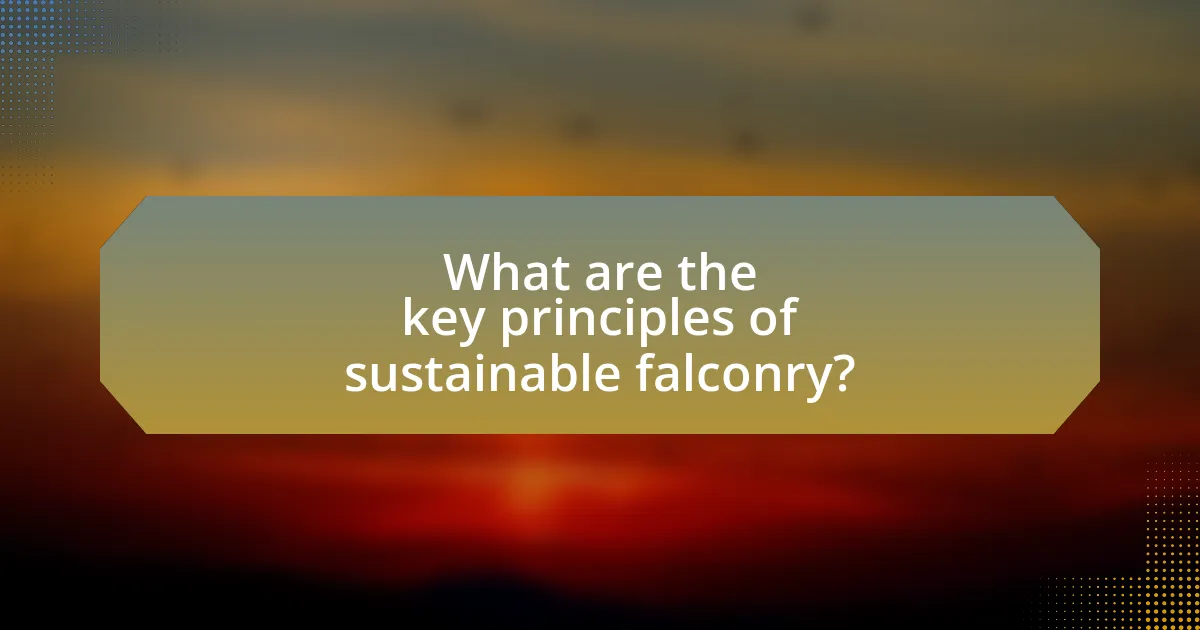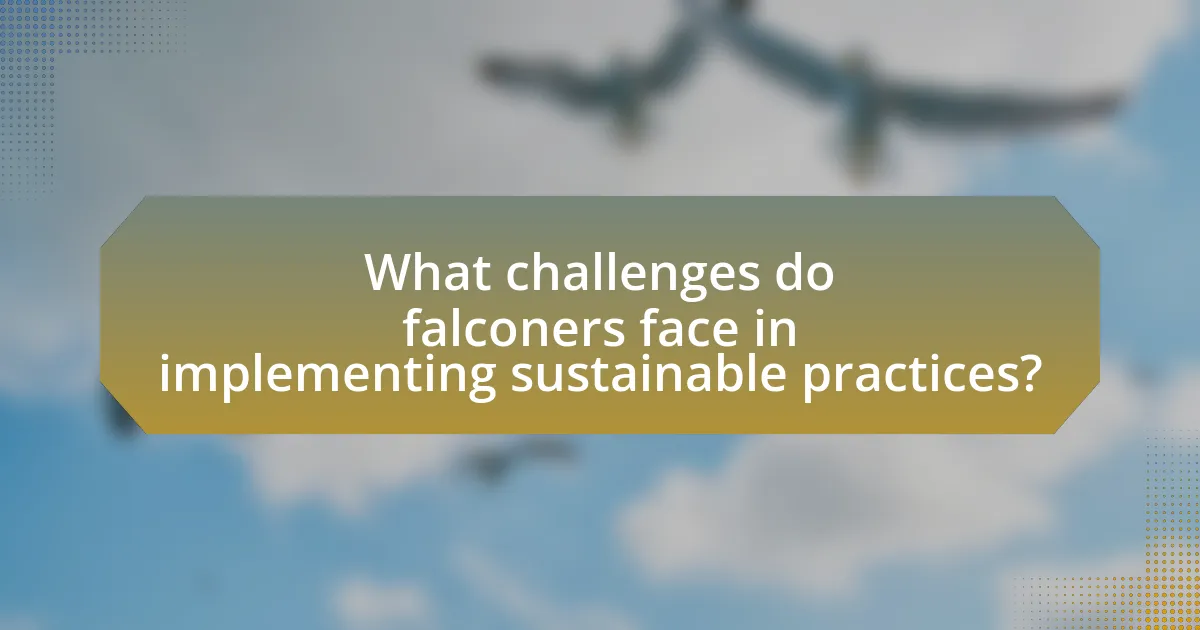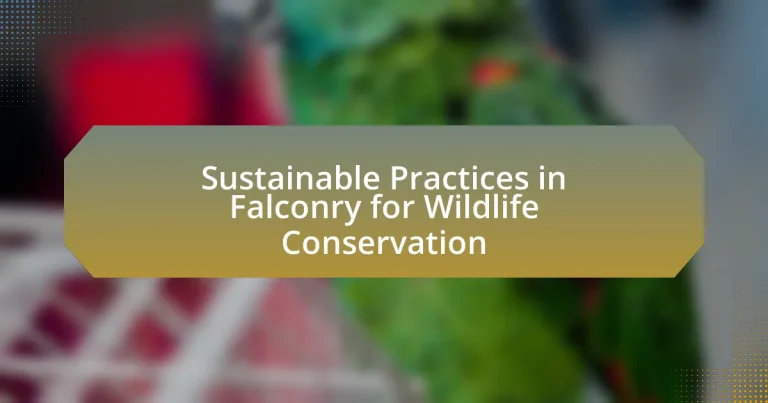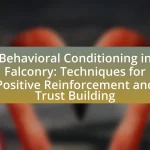Sustainable practices in falconry play a crucial role in wildlife conservation by promoting habitat preservation, responsible breeding, and ethical hunting methods. These practices enhance genetic diversity, support raptor populations, and maintain ecological balance, contributing to overall biodiversity. Falconers engage in initiatives such as habitat restoration and public education, fostering community involvement in conservation efforts. The article explores specific techniques used in sustainable falconry, the impact on local ecosystems, and the challenges faced by falconers in implementing these practices, highlighting the importance of collaboration with conservation organizations for effective wildlife protection.
What are Sustainable Practices in Falconry for Wildlife Conservation?

Sustainable practices in falconry for wildlife conservation include habitat preservation, responsible breeding, and ethical hunting methods. Habitat preservation ensures that the natural environments where raptors thrive are maintained and protected from degradation. Responsible breeding practices involve the careful selection of breeding pairs to enhance genetic diversity and reduce the risk of inbreeding, which is crucial for the long-term viability of raptor populations. Ethical hunting methods prioritize the well-being of both the falcon and the prey species, ensuring that hunting is conducted in a manner that does not threaten local wildlife populations. These practices contribute to the overall health of ecosystems and support conservation efforts by fostering a balance between human activities and wildlife needs.
How do sustainable practices in falconry contribute to wildlife conservation?
Sustainable practices in falconry contribute to wildlife conservation by promoting the responsible management of raptor populations and their habitats. These practices include breeding programs that enhance genetic diversity and reintroduction efforts for endangered species, which help restore ecological balance. For instance, the use of captive breeding has successfully increased populations of species like the California condor, demonstrating a direct link between falconry practices and conservation outcomes. Additionally, falconers often engage in habitat preservation initiatives, ensuring that the ecosystems supporting both raptors and their prey are maintained, further supporting biodiversity.
What specific techniques are used in sustainable falconry?
Sustainable falconry employs techniques such as habitat management, ethical breeding practices, and responsible hunting methods. Habitat management involves maintaining and restoring natural environments to support both raptors and their prey, ensuring a balanced ecosystem. Ethical breeding practices focus on preserving genetic diversity and minimizing inbreeding, which is crucial for the health of raptor populations. Responsible hunting methods include using trained birds of prey to control pest populations without causing harm to non-target species, thereby promoting ecological balance. These techniques are supported by conservation organizations that emphasize the importance of sustainable practices in wildlife management.
How do these techniques impact local ecosystems?
Sustainable practices in falconry positively impact local ecosystems by promoting biodiversity and enhancing habitat conservation. These techniques, such as responsible breeding and release programs, help maintain healthy populations of both raptors and their prey species. For instance, studies have shown that falconry can aid in controlling pest populations, thereby reducing the need for chemical pesticides that can harm other wildlife. Additionally, falconers often engage in habitat restoration efforts, which further supports ecosystem health by improving the living conditions for various species.
Why is falconry considered a tool for wildlife conservation?
Falconry is considered a tool for wildlife conservation because it promotes the understanding and protection of raptor species and their habitats. By engaging in falconry, practitioners contribute to the conservation of these birds through breeding programs, habitat restoration, and public education initiatives. For instance, falconers often participate in efforts to rehabilitate injured raptors and release them back into the wild, thereby supporting population recovery. Additionally, studies have shown that falconry can foster a greater appreciation for biodiversity, leading to increased advocacy for wildlife conservation efforts.
What role do falconers play in conservation efforts?
Falconers play a crucial role in conservation efforts by participating in the rehabilitation and release of injured raptors, thereby contributing to the preservation of bird populations. Through their expertise in handling and training birds of prey, falconers often collaborate with wildlife organizations to rescue and rehabilitate these birds, ensuring their survival and reintegration into their natural habitats. Additionally, falconers engage in educational outreach, raising awareness about the importance of raptor conservation and the ecological roles these birds play. This combination of rehabilitation and education supports broader conservation initiatives aimed at protecting ecosystems and biodiversity.
How does falconry promote biodiversity?
Falconry promotes biodiversity by fostering the conservation of various bird species and their habitats. Practitioners of falconry often engage in breeding programs for raptors, which helps maintain genetic diversity and supports the populations of these birds in the wild. Additionally, falconers contribute to habitat preservation efforts, as they recognize the importance of healthy ecosystems for their birds. Studies have shown that falconry can raise awareness about the need for wildlife conservation, leading to increased public support for biodiversity initiatives. For instance, the International Association for Falconry and Conservation of Birds of Prey emphasizes the role of falconry in educating the public about the ecological significance of raptors and their prey species, thereby promoting a broader understanding of biodiversity.
What are the key principles of sustainable falconry?

The key principles of sustainable falconry include ethical hunting practices, habitat conservation, and species protection. Ethical hunting practices ensure that falconers only take what is necessary for their needs, minimizing the impact on local wildlife populations. Habitat conservation involves maintaining and restoring natural environments to support both raptors and their prey, which is essential for the long-term viability of falconry. Species protection focuses on adhering to regulations that safeguard endangered or threatened species, ensuring that falconry does not contribute to their decline. These principles are supported by various conservation organizations that promote responsible falconry as a means of fostering a deeper connection to wildlife and encouraging conservation efforts.
How can falconers ensure ethical treatment of birds?
Falconers can ensure ethical treatment of birds by adhering to established welfare standards and best practices in falconry. These standards include providing adequate nutrition, proper housing, and regular veterinary care to maintain the health and well-being of the birds. Research indicates that falconers who follow guidelines set by organizations like the North American Falconers Association demonstrate a commitment to ethical practices, which includes training methods that prioritize the bird’s welfare and minimize stress. Additionally, falconers should engage in conservation efforts, such as participating in breeding programs for endangered species, which further supports ethical treatment and wildlife conservation.
What guidelines exist for the care and training of falcons?
Guidelines for the care and training of falcons include providing a suitable environment, proper nutrition, and consistent training methods. A suitable environment involves a spacious aviary that allows for flight and exercise, while proper nutrition consists of a balanced diet rich in proteins, vitamins, and minerals, typically including whole prey or specially formulated diets. Consistent training methods emphasize positive reinforcement techniques, such as rewarding desired behaviors with food or praise, and gradually introducing the falcon to various stimuli to build confidence and adaptability. These practices are essential for maintaining the health and well-being of falcons, as well as ensuring their effectiveness in falconry, which contributes to wildlife conservation efforts by promoting sustainable hunting practices.
How does ethical treatment affect conservation outcomes?
Ethical treatment significantly enhances conservation outcomes by fostering trust and cooperation between conservationists and local communities. When communities perceive ethical treatment in conservation efforts, they are more likely to engage in sustainable practices and support wildlife protection initiatives. For instance, studies have shown that ethical engagement leads to increased local participation in conservation programs, resulting in improved biodiversity and habitat preservation. A report by the World Wildlife Fund indicates that ethical approaches in conservation can lead to a 30% increase in community involvement, which directly correlates with better conservation results.
What are the environmental impacts of falconry?
Falconry can have both positive and negative environmental impacts. On the positive side, falconry promotes conservation awareness and can contribute to the protection of raptor species through breeding programs and habitat preservation efforts. For instance, falconers often engage in initiatives that support the conservation of wild habitats, which benefits various species within those ecosystems. Conversely, negative impacts may include the potential for overharvesting of wild birds for training purposes, which can disrupt local populations and ecosystems. Additionally, the introduction of non-native species through falconry practices can lead to ecological imbalances. Studies indicate that responsible falconry practices, when aligned with conservation goals, can mitigate these negative effects while enhancing biodiversity.
How does falconry influence prey populations?
Falconry influences prey populations by regulating their numbers through controlled hunting practices. This method of hunting can help maintain ecological balance by preventing overpopulation of certain prey species, which can lead to habitat degradation and resource depletion. Studies have shown that falconry can contribute to the management of prey species, such as rabbits and pigeons, by reducing their populations in specific areas, thereby promoting healthier ecosystems. Additionally, falconry often involves the release of prey species back into the wild, which can support genetic diversity and population stability.
What measures can be taken to minimize negative impacts?
To minimize negative impacts in falconry for wildlife conservation, practitioners should implement habitat management, responsible breeding practices, and public education initiatives. Habitat management involves maintaining and restoring natural environments to support both raptors and their prey, which can enhance ecosystem balance. Responsible breeding practices ensure genetic diversity and reduce the risk of inbreeding, which is crucial for the health of raptor populations. Public education initiatives raise awareness about the importance of conservation and promote ethical falconry practices, thereby fostering community support for wildlife protection. These measures collectively contribute to the sustainability of falconry while protecting wildlife and their habitats.
What challenges do falconers face in implementing sustainable practices?

Falconers face several challenges in implementing sustainable practices, primarily due to regulatory constraints, habitat loss, and the need for specialized knowledge. Regulatory constraints often limit the types of birds that can be used and the methods of training, which can hinder the adoption of more sustainable practices. Habitat loss, driven by urbanization and agricultural expansion, reduces the availability of natural prey and nesting sites, making it difficult for falconers to maintain healthy populations of raptors. Additionally, the specialized knowledge required for sustainable falconry practices is not widely disseminated, leading to inconsistent application among practitioners. These factors collectively impede the effective implementation of sustainable practices in falconry, which is essential for wildlife conservation efforts.
How do regulations affect sustainable falconry practices?
Regulations significantly influence sustainable falconry practices by establishing guidelines that promote ethical treatment of birds and conservation of wildlife. These regulations often include licensing requirements, habitat protection measures, and restrictions on the capture and breeding of raptors, which help ensure that falconry is conducted in a manner that does not harm local ecosystems. For instance, the Migratory Bird Treaty Act in the United States protects certain species of birds, requiring falconers to adhere to specific legal frameworks that support biodiversity and prevent overexploitation. By enforcing these regulations, authorities can mitigate negative impacts on bird populations and their habitats, thereby fostering sustainable practices within the falconry community.
What are the common legal hurdles for falconers?
Common legal hurdles for falconers include obtaining the necessary permits, adhering to wildlife protection laws, and complying with regulations regarding the capture and ownership of birds of prey. Falconers must navigate state and federal laws that govern the licensing process, which often requires proof of training and experience. Additionally, falconers face restrictions on the species they can capture and keep, as many birds are protected under the Migratory Bird Treaty Act and other conservation laws. Violating these regulations can result in fines or loss of permits, emphasizing the importance of understanding and following legal requirements in falconry.
How can falconers navigate these regulations effectively?
Falconers can navigate regulations effectively by staying informed about local, state, and federal laws governing falconry. Regularly consulting resources such as the U.S. Fish and Wildlife Service and state wildlife agencies provides updates on legal requirements and changes in regulations. Additionally, joining falconry associations offers access to educational materials, workshops, and networking opportunities with experienced falconers who can share best practices for compliance. Engaging in ongoing education about sustainable practices in falconry also ensures that falconers align their activities with conservation goals, thereby reinforcing their commitment to wildlife protection.
What are the social challenges in promoting sustainable falconry?
Promoting sustainable falconry faces several social challenges, including cultural resistance, lack of awareness, and conflicting interests among stakeholders. Cultural resistance arises from traditional practices that may not align with sustainable methods, making it difficult to shift mindsets. Lack of awareness about the ecological benefits of sustainable falconry can hinder community support and participation. Additionally, conflicting interests among various stakeholders, such as conservationists, falconers, and policymakers, can create barriers to implementing sustainable practices effectively. These challenges must be addressed to foster a collaborative approach towards sustainable falconry that benefits wildlife conservation.
How can public perception of falconry be improved?
Public perception of falconry can be improved through education and community engagement initiatives. By providing accurate information about the ecological benefits of falconry, such as its role in wildlife conservation and biodiversity, organizations can foster a better understanding of the practice. For instance, studies have shown that falconry can aid in controlling pest populations, which contributes to ecosystem balance. Additionally, hosting public demonstrations and workshops can allow people to experience falconry firsthand, dispelling myths and showcasing the skill and dedication involved. Engaging with local communities and schools can further enhance awareness and appreciation for falconry as a sustainable practice.
What role do education and outreach play in conservation efforts?
Education and outreach are crucial in conservation efforts as they raise awareness and foster community engagement. By informing the public about the importance of biodiversity and the threats facing wildlife, education initiatives can lead to increased support for conservation policies and practices. For instance, programs that educate individuals about sustainable practices in falconry can promote responsible bird handling and habitat preservation, ultimately benefiting wildlife populations. Research indicates that communities involved in educational outreach are more likely to participate in conservation activities, as evidenced by a study published in the Journal of Environmental Management, which found that educational programs significantly increased local involvement in conservation efforts.
What practical steps can falconers take to enhance sustainability?
Falconers can enhance sustainability by implementing habitat conservation practices. This includes actively participating in the restoration and preservation of natural habitats that support both wild raptors and their prey. For instance, falconers can engage in local conservation projects that focus on reforestation or wetland restoration, which are crucial for maintaining biodiversity. Additionally, falconers should adopt responsible breeding practices to ensure genetic diversity and reduce the reliance on wild populations. Studies have shown that sustainable breeding programs can help maintain healthy raptor populations while minimizing the impact on wild ecosystems. Furthermore, falconers can educate the public about the importance of raptor conservation, thereby fostering a greater appreciation for wildlife and encouraging community involvement in conservation efforts.
What best practices should falconers adopt for conservation?
Falconers should adopt habitat preservation, responsible breeding, and public education as best practices for conservation. Habitat preservation involves protecting and restoring natural environments where raptors thrive, which is crucial for maintaining biodiversity. Responsible breeding practices ensure genetic diversity and the health of captive populations, reducing the risk of inbreeding and supporting species recovery efforts. Public education initiatives raise awareness about the importance of raptors in ecosystems and promote conservation efforts, fostering community support for wildlife protection. These practices are supported by studies indicating that habitat loss is a primary threat to raptor populations, and community engagement is essential for effective conservation strategies.
How can falconers collaborate with conservation organizations?
Falconers can collaborate with conservation organizations by participating in habitat restoration projects and contributing to species monitoring efforts. This collaboration allows falconers to apply their expertise in raptor care and behavior to support conservation initiatives, such as tracking population dynamics and enhancing breeding programs. For instance, falconers can assist in the reintroduction of endangered species by providing training and rehabilitation for birds before their release into the wild. Additionally, partnerships can facilitate educational outreach, where falconers share knowledge about raptor conservation with the public, thereby raising awareness and fostering community support for wildlife protection efforts.


